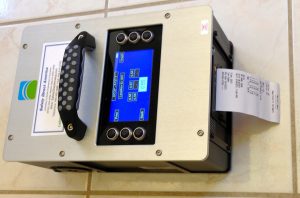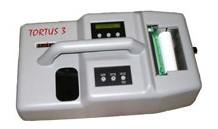Other Sometimes Reliable Floor Slip Test Methods
Other reliable DCOF slip tests exist besides the pendulum DCOF test, although the pendulum is the most widely used and accepted around the world, and the other DCOF testers have a much more limited use.
SlipAlert (iAlert) Slip Resistance Tester
The SlipAlert Tribometer (now marketed as the iAlert Slip Meter) can quickly measure the slip resistance of a floor in the field with very little training by the user so that property owners, safety officers and maintenance crews can monitor the slipperiness of their flooring over time, such as before and after cleaning and after thousands of people have walked across it. The iAlert Floor Friction Tester (or SlipAlert Tribometer) has a published British standard that’s been in use for many years now, which means it has been shown to have reproducibility and precision. The SlipAlert (iAlert Slip Tester) comes with two rubber sliders that mimic shoe soles (softer rubber sliders can also be ordered through us for barefoot areas such as pools and shower areas), a rechargeable lithium ion battery, the ramp, a chart to interpret slip resistance test results, and everything else needed to measure the slip potential of your floors reliably without any special training. It has been shown to have excellent correlation with pendulum dynamic coefficient of friction (DCOF) floor slip resistance tester results, and the pendulum slip tester is easily the most widely-used and reliable floor slip resistance test device in the world today.
BOT-3000E, but not for assessing safety!
The BOT-3000E digital tribometer was used for previous test standards ANSI B101.1, B101.3, and A137.1. These tests all gave or continue to give false safety data and say that some very slippery floors are not slippery at all. Never use these tests as safety assessments. The test method used now is ANSI A326.3, as the all others have now expired for being too generous to slippery floors.
ANSI A326.3 states, “The coefficient of friction (COF) measurement provided in this standard is an evaluation of hard surface flooring materials under known conditions using a standardized sensor material prepared according to a specific protocol. As such it can provide a useful comparison of surfaces, but does not predict the likelihood a person will or will not slip on a hard surface flooring material.” Therefore, this test must never be used to assess safety or real-world slip resistance. The values given in the test method are “generally accepted minimums”, not values above which are considered safe. If you want to assess safety, you’ll need a pendulum DCOF slip resistance test.

BOT-3000E Digital Tribometer
As a monitoring device, tests are made with the pendulum, then the BOT-3000E. The building owner can then make sure, with regular testing with the BOT-3000E, that the floors are maintaining their slip resistance over time, and after routine maintenance, with an easy-to-use instrument, such as the BOT-3000E or SlipAlert (above). Again, the BOT-3000E is not for assessing safety, but can be used in conjunction with the pendulum DCOF tester to monitor changes in slip resistance.
Static friction is applicable to a pedestrian who is standing still on a floor. A floor that is slip resistant will be non-slip for someone who is in motion across the floor. Static coefficient of friction slip testing has therefore been proven to be irrelevant, especially in the wet condition. Anyone who has ever, or continues to sell static coefficient of friction (SCOF) testing as a valid way of assessing the actual slip resistance of a wet floor is either profoundly incompetent in the field of floor slip resistance testing, or they have been or are presently purposefully misleading their clients for a quick buck.
The two biggest scams left in the world today in regards to SCOF “testing” are ASTM D2047 and ANSI B101.1-22. Use these as a “safety test” if you like paying your lawyer weekly for slip and fall messes he or she must clean up for you.
Tortus Tribometer
The Tortus digital slip tester (tribometer) has been endorsed by the Ceramic Tile Institute of America (CTIOA) since 2001 as a secondary standard, with the pendulum test being the primary standard test device for assessing real-world floor slip resistance, or coefficient of friction (COF). One advantage of the Tortus over the pendulum is that it can perform many slip tests in a short period of time, dry and wet. The CTIOA method as well as the Australian standard AS4586-2013 have endorsed a minimum dynamic coefficient of friction for level floors of 0.50 using the Tortus slip resistance test using hard FourS (standard shoe sole simulating) rubber. Here you can find a Tortus video demonstration.
The safety criterion of 0.50 applies only to the Tortus tribometer, not to all tribometers. It is generally recommended that one get a minimum PTV of 36 for “low slip potential” using the pendulum DCOF test. The BOT-3000E uses the DCOF of 0.42 as their absolute minimum to achieve some sort of slip resistance (and that’s usually setting a very low bar, in most cases.) Every slip resistance tester, or tribometer, will have its own safety criterion based on research. Anyone who says there is some “universal” DCOF number that signifies a safe floor is someone who either cannot be trusted, or is someone who does not understand how science works.

Tortus III Tribometer
